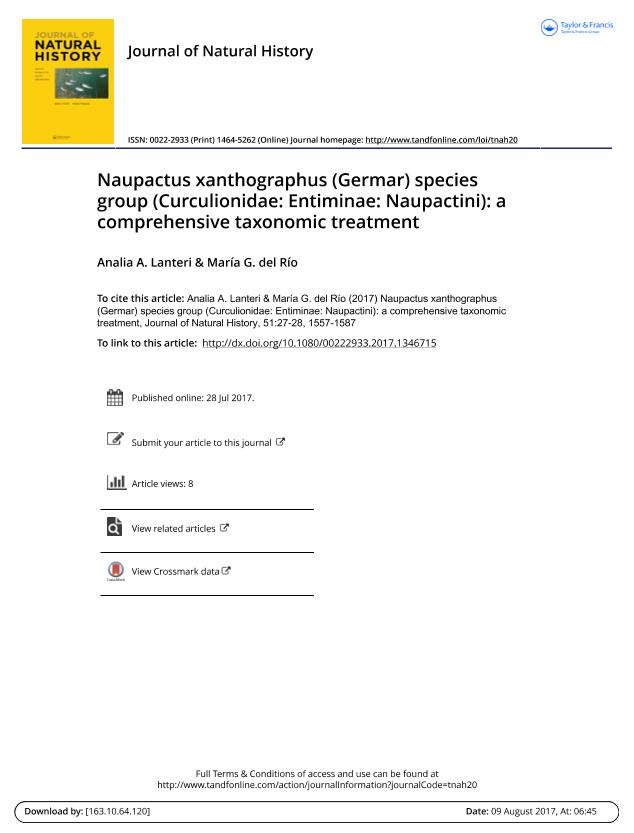Artículo
Naupactus xanthographus (Germar) species group (Curculionidae: Entiminae: Naupactini): a comprehensive taxonomic treatment
Fecha de publicación:
07/2017
Editorial:
Taylor & Francis Ltd
Revista:
Journal of Natural History
ISSN:
0022-2933
Idioma:
Inglés
Tipo de recurso:
Artículo publicado
Clasificación temática:
Resumen
We undertake a taxonomic revision of Naupactus xanthographus (Germar 1824) (grape-fruit weevil) and the putative related species N. navicularis Boheman 1840, N. dissimilis Hustache 1947, N. mimicus Hustache 1938, N. dissimulator Boheman 1840 and N. marvaldiae new species. This species group mainly differs from other Naupactus by the presence of a pair of tubercles at the apex of the elytra. It ranges in Argentina, southern Brazil, Bolivia, Paraguay and Uruguay, in areas that belong to the biogeographic provinces of Atlantic, Araucaria and Paraná forests, Yungas, Chaco and Pampa. Naupactus xanthographus is broadly distributed in Argentina, mainly in the Pampean province, and it was introduced in central Chile, where it is considered a serious pest of grapes and several fruit trees. The remaining species are partially sympatric in the subtropical forests of southern Brazil, and N. dissimulator ranges along the gallery forests of Paraná and Uruguay rivers, down to La Plata River. It has been reported damaging citrus and ‘yerba mate’, like N. navicularis and N. dissimilis. The new species N. marvaldiae ranges in southern Brazil and north-eastern Argentina (Misiones), and differs from N. dissimulator, mainly by the very short elytra, the apical tubercles welldeveloped in males and females, the broader front femora, and the different shape of the apex of the penis. The other four species are probably more closely related and they separate from the pair N. dissimulator–N. marvaldiae because of the slightly widened front femora, well-developed corbels of the hind tibiae, and short to indistinct nodulus of the spermatheca.
Palabras clave:
Fruit Weevils
,
Geographic Distribution
,
Neotropics
,
South America
,
Taxonomy
Archivos asociados
Licencia
Identificadores
Colecciones
Articulos(CCT - LA PLATA)
Articulos de CTRO.CIENTIFICO TECNOL.CONICET - LA PLATA
Articulos de CTRO.CIENTIFICO TECNOL.CONICET - LA PLATA
Citación
Lanteri, Analía Alicia; del Rio, Maria Guadalupe; Naupactus xanthographus (Germar) species group (Curculionidae: Entiminae: Naupactini): a comprehensive taxonomic treatment; Taylor & Francis Ltd; Journal of Natural History; 51; 27-28; 7-2017; 1557-1587
Compartir
Altmétricas




